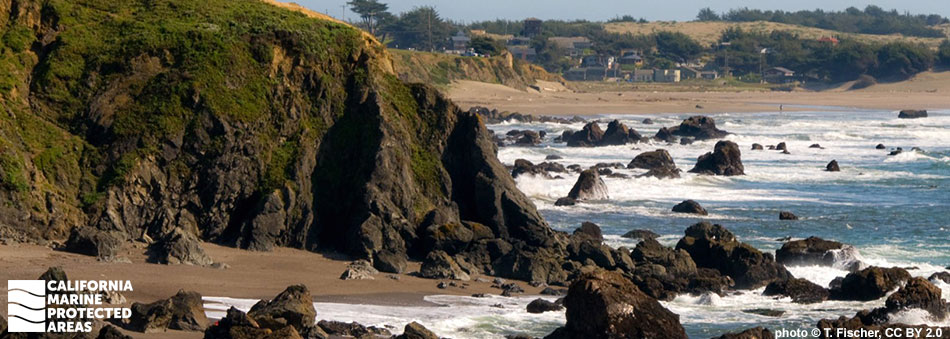
Overview
Russian River State Marine Conservation Area (SMCA) and Russian River State Marine Recreational Management Area (SMRMA) are connected marine managed areas lying at the mouth of the Russian River in Sonoma County, 50 miles northwest of San Francisco. The Russian River empties fresh water into the Pacific Ocean at the juncture of these marine managed areas. The SMCA protects less than one square mile extending offshore from the mouth of the river to depths of around 60 feet, and the SMRMA protects less than a half square mile extending from the beach at the mouth of the river inland to the brackish waters at the bridge of Highway 1.
The nearshore and estuarine ecosystems protected within Russian River SMCA and SMRMA are rare along this stretch of the California coast and support several unique habitats and a rich biodiversity. The sandy beaches, rocky shores, submerged reef, and kelp forests of the SMCA protect salmonids like steelhead trout and coho and Chinook salmon, which return to the Russian River to reproduce. Gray whales are frequently spotted cruising by during their migration to and from Baja Mexico, and harbor seals and sea lions hauled out on the sandbar at the river mouth can be heard barking over the crash of the waves.
The coastal marsh and estuary of the SMRMA also protect salmonids, which aggregate at the mouth of the estuary during seasonal sandbar closures. Surfperch, American shad, and bay pipefish, as well as river otters and wetland birds use this ocean-river corridor for critical life history stages. Birdwatching, surfing, kayaking, and hiking can be enjoyed in the area, a popular destination for those who seek to witness the meeting of river and sea.
Regulations
Russian River SMCA
It is unlawful to injure, damage, take, or possess any living, geological, or cultural marine resource, EXCEPT:
Recreational and commercial take of Dungeness crab by trap is allowed. Recreational take of surf smelt by hand-held dip net or beach net is allowed.
California Code of Regulations Title 14, Section 632(b)(38)(opens in new tab)
Russian River SMRMA
It is unlawful to injure, damage, take, or possess any living, geological, or cultural marine resource, EXCEPT:
Take of waterfowl in accordance with general waterfowl regulations is allowed.
California Code of Regulations Title 14, Section 632(b)(37)(opens in new tab)
Quick Facts
Russian River SMCA
MPA size: 0.84 square miles
Shoreline span: 1.4 miles
Depth range: 0 to 57 feet
Habitat composition*:
- Rock: 0.69 square miles
- Sand/mud: 0.57 square miles
Russian River SMRMA
SMRMA size: 0.36 square miles
Shoreline span: 1.44 miles
Depth range: 0 to 10 feet
Habitat composition*:
- Estuary: 0.02 square miles
- Coastal marsh: 0.78 square miles
*Habitat calculations are based on three-dimensional area and may exceed the total MPA area listed above.